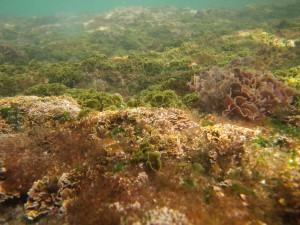20th May 2015 Los Angeles, USA
Microalgae Mission to USA
Slimy isn’t the first word that comes to mind when you think of Phoenix, Arizona. But in March, 13 delegates from the UK had a chance to view Arizona State University’s amazing selection of ponds – and green slime. ASU’s facility is just one of five algae testbeds in the US as part of the Department of Energy’s Algae Testbed Public-Private Partnership (ATP3). As the sun shone intensely on us (some of us came from 3°C Scotland!), the group meandered around the ponds in awe and envy. This wasn’t just slime – this was microalgae. And it’s a huge area of growing development in the UK.
The UK is already tapping into the enormous commercial potential of microalgae – single cell organisms found in our seas and waterways that are capable of supplying us with essential medicines, food, materials and fuel. But we still lack many of the connections and resources available in the US.
In association with a UK business-funding agency, Innovate UK, and the Natural Environment Research Council (NERC), my company has created a network (ABSIG) to communicate and facilitate algae activities. Now we have something new: BBSRC PHYCONET is a specialized academic-led network aimed at facilitating collaborations between industry and academia in the area of high value chemicals from microalgae. That’s how I, along with five companies and seven academics ended up on our “Microalgae Mission to USA.”
On the second day, we flew to San Diego and met with academic and entrepreneur, Steve Mayfield, at University College of San Diego for an interesting discussion around therapeutic proteins and astaxanthin. In Greg Mitchell’s lab at the Scripps Institute for Oceanography, we learned how they are exploring ways to grow microalgae off industrial flu gas, while helping manufacturers reduce their CO2 emissions. Next on the agenda was a meeting with Synthetic Genomics Inc, where they described their Archetype platform, a genomic database with very impressive functionality. Following a lunch meeting with Global Algae Innovation and Clean Tech San Diego, the delegates were shuttled off for a tour of the UCSD Biology Field Station. It was good to see some green ponds bubbling away and demonstrating how students built raceway ponds to grow their own algae. The final two days of the Study Tour were spent at the Food and Fuel For the 21st Century conference at UCSD. The conference was a great opportunity to learn about basic research being conducted in the US, and hear two UK colleagues showcase their research as well.
The Microalgae Mission to USA ended in glorious sunshine at UCSD but with a sense of purpose. The delegates departed with new and valuable contacts. KTN, BBSRC PHYCONET and UK SIN left resolved to develop stronger US/UK partnerships. And we all returned home with a little much-needed vitamin D!
Michelle Carter
Knowledge Transfer Manager
The Knowledge Transfer Network